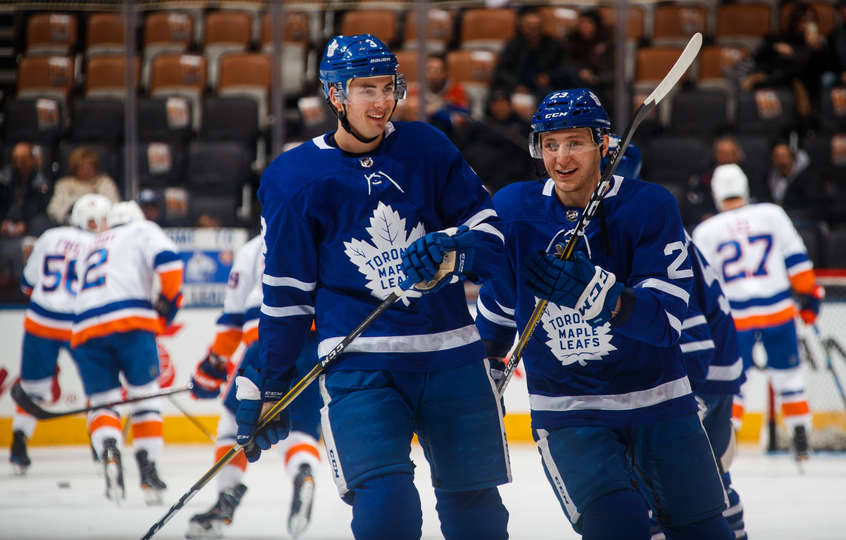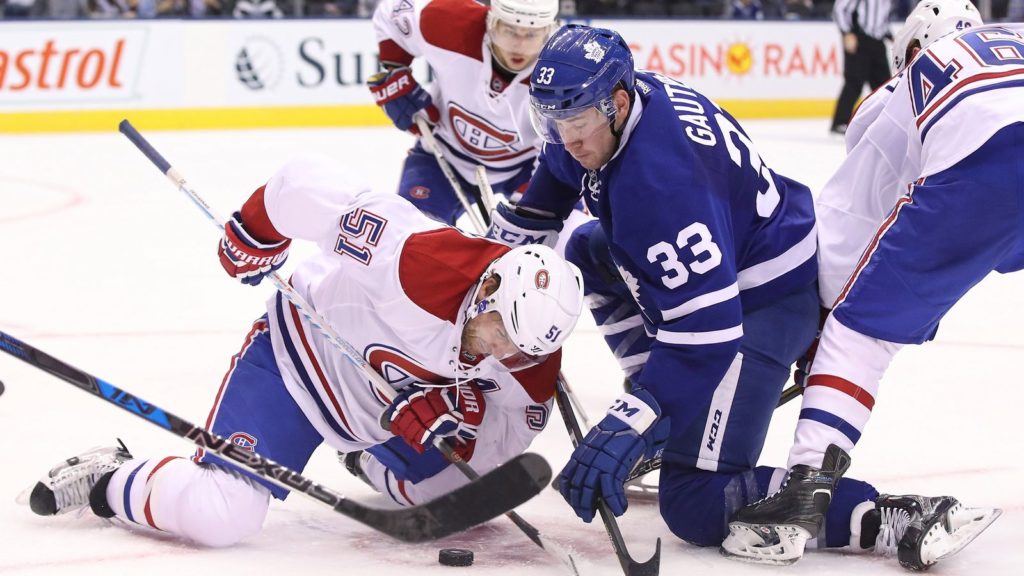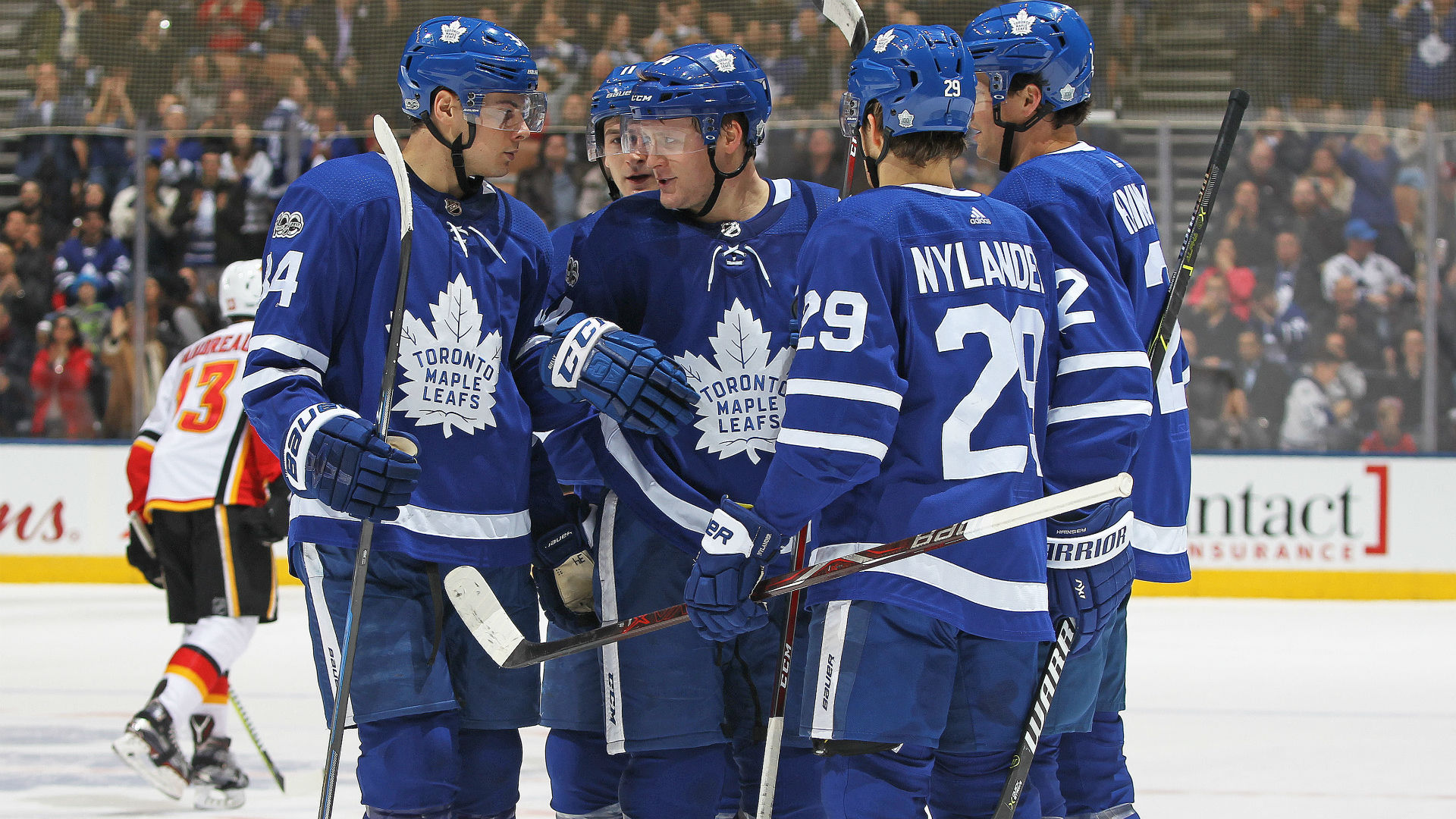The Toronto Maple Leafs 2018 training camp roster has been released today, with camp set to open with physicals and media obligations on Thursday.
Absent from the training camp roster were any invitees on Player Tryout Agreements, which partly speaks to the depth the Leafs have at their disposal entering the highly-anticipated 2018-19 season. By and large, their forwards 1-13 and defensemen 1-5 are set before camp even begins.
That doesn’t mean there won’t be some intriguing developments to keep an eye on throughout training camp and exhibition season, though. Below are five storylines to watch that aren’t William Nylander’s contract situation.
The Backup Goaltending Battle

The Leafs had a capable veteran backup last season in the returning Curtis McElhinney, who posted .934 save percentage over 18 appearances — tops among goalies that played less than 30 games but more than five (i.e. regular backups). Arguably, the only issue at this position last year was that they didn’t use McElhinney enough in order to rest Andersen down the stretch when the team’s playoff spot was long since secured.
Meanwhile, the Marlies’ goaltending tandem of Calvin Pickard and Garret Sparks earned the Hap Holmes Award award for best combined save percentage during the AHL regular season. Sparks carried the load in the playoffs en route to a Calder Cup championship, posting a .915 save percentage and a 14-5 record in the postseason. He’s earned a fair look at camp, as has Pickard.
Babcock’s trust in the backup is a huge factor in this decision. Andersen needs to be given more rest than he was last season — the Leafs need him to be better than the .895 save percentage he posted in the final 12 games of the season and the .896 he posted in the seven-game series against Boston. The concern is that it might only take a poor performance from Garret Sparks or Calvin Pickard early in the season for the results-oriented Babcock to essentially Jhonas Enroth one of them: kept on an extremely short leash, out of the organization in short order should they falter.
Whether that’s fair or not, for Andersen’s sake, the Leafs cannot be in a situation again where Babcock doesn’t trust the backup.
In that respect, McElhinney has earned some rope from Babcock because he was excellent last season and came up clutch down the stretch the season before. He’s shown he can be called on to play sparingly, almost always behind a tired team in a back-to-back situation, and get the job done while supporting Andersen in between.
That’s not an easy task for a young-ish goaltender who is still developing, adjusting to the NHL level, and is used to playing regularly in the AHL. It’s a very different job description than that of an everyday starter, not to mention the step up in competition level. As good as Sparks was in the AHL last season — and as unfair as it was to expose him for as long as they did during his NHL stint in the tank year in 2015-16 — he has not proven anything at this level yet at a position that is very hard to project from one level to the next. Pickard, on the other hand, has a little more experience as a backup goaltender in the NHL from his time in Colorado.
That is what gets lost a little bit in the discussion about asset management and Sparks’ value to the organization long term. It likely means Sparks is going to need to have a big camp and preseason to take the spot from the incumbent in McElhinney. It’s hard to picture Babcock not going with what he knows and trusts here, barring a poor camp/preseason from McElhinney and a fantastic one from Sparks or Pickard that makes the coaching staff’s minds up for them.
We know Dubas has tested the trade market a little bit this summer to get a sense of where things stand with his depth goaltenders. Whoever it is that loses out here — two of Pickard, McElhinney, and Sparks — there may be an attempt to move him/them via trade, but the difficulty when it comes to fetching much value here is that they could be had on waivers for free. Best case, the Leafs may be able to fetch a mid-level draft pick.
The question the Leafs need to decide on is which goaltender is best suited to play 20-25 games next season, putting Andersen’s workload somewhere north of 55 starts but south of 65.
The Right Side of the Bottom Pair

Justin Holl (right handed), Igor Ozhiganov (right handed), Connor Carrick (right handed), Martin Marincin (left handed), Calle Rosen (left handed), Andreas Borgman (left handed) — there are lots of names in the mix here for what is the most wide-open lineup spot entering 2018 training camp.
Ozhiganov comes armed with the assurance he’ll receive a good, hard look for an NHL job out of camp, having uprooted his life and left money on the table back in Russia (he also has a Euro assignment clause in his contract). He brings some jam to a blue line that lost Roman Polak this past summer and might be too light in that area for Babcock’s tastes.
Justin Holl had a successful two-game cameo for the Leafs, played top pairing minutes for the Marlies in their Calder Cup run, has killed penalties at the AHL level, and is a highly mobile puck mover on a blueline Dubas is looking to shape in that image. He brings some size at 6’3, although he’s not particularly physical.
Connor Carrick has proven he can take a competent enough shift in a bottom pairing role, although he’s got the known-quantity/old-news feel to him and has never had the biggest of fans in Babcock.
Martin Marincin has Babcock’s trust and affection on the penalty kill, but he battles confidence issues and struggles to move the puck at the NHL level, a problem that would only be exacerbated on his offside.
Andreas Borgman, who also is a lefty, claimed a job right out of camp last year with his mature frame, aggressive physical play and decent puckmoving skills, but he wasn’t quite ready for prime time and returned to the Marlies for the rest of the season before missing out on the playoffs due to injury. Fellow countryman Calle Rosen really came into his own down the stretch and into the playoffs for the Marlies — where his ability to jump up in to the rush, move the puck, and his booming slapshot were regular features — but he might represent too much of the same on a defence that would lack a cross-section of different player types (he’s also a lefty).
The right-handers have the distinct edge here and the penalty kill will also be a major determining factor.
The Final Top Nine Left Wing Spot

Identifying the need for another top nine option on the left wing — where the team lost James van Riemsdyk over the summer — Kyle Dubas took a flyer in early July on Tyler Ennis, who has a track record of producing in the NHL but has one foot out of the league at this point and has much to prove. Never well regarded for his defensive/ checking game, nor does he have much experience on the penalty kill, the matter of the left wing depth chart appears to come down to how the deployment shakes out up front.
If the left wing spot next to Kadri — previously occupied by Marleau, who is expected to move up next to Matthews, with Marner now next to Tavares — means that this player will be seeing a fair number of tough matchups on home ice, then it may be a job better suited for Andreas Johnsson, whose 200 foot game is well regarded by Babcock for a relatively inexperienced player.
If this line is consistently used as a secondary scoring line that is sheltered by the cover of the Tavares and Matthews lines, though, it opens up the possibility of finally giving Josh Leivo his fair shake in this spot — he could also contribute at the net front of the second power-play unit, it should be noted — or it could be Ennis’ spot with a good camp showing.
Fourth Line Center Competition

This spot appears to be earmarked for Par Lindholm. The Swedish pivot had a good amount of interest in him from around the league and has a Euro assignment clause in his contract, so he appears to be arriving with a leg up on the competition.
Having spoken to his agent about the courting process back in the Spring, Lindholm thinks he has a fan in Mike Babcock, but ask Miro Aaltonen about how far that will take you if the expectation doesn’t meet reality in camp and preseason. Lindholm has a track record as a capable draw taker and penalty killer in the SHL, but he’ll need to prove that he can do those things for Babcock in the NHL and be effective on the smaller ice surface against stiffer competition. The PK and faceoff circle are essential parts of the job description as a 4C under the Leafs head coach.
Also in the mix here is Frederik Gauthier, who after battling back from a serious knee injury last Fall to return to the Marlies lineup ahead of schedule, slowly came along throughout the season and was effective in the playoffs alongside Colin Greening on a matchup line for head coach Sheldon Keefe. Babcock loves that his size never changes (6’5 every night!) and Gauthier’s ability on the draw, and he has used him at the fourth-line spot before in four separate big-club stints.
Gauthier, it’s worth noting, is no longer waiver exempt.
The Leafs are leaving this open to a competition between a Euro signing, a few young internal options, and NHL/AHL tweener depth pieces in Adam Cracknell and Josh Jooris in hopes of solving the revolving door situation at fourth-line center with a more permanent solution. That is somewhat surprising given the Leafs have been forced to shed quality draft picks to add fourth line centres at the past two deadlines due to the lack of stability at this spot in the lineup, but perhaps it speaks to the organization’s regard for Lindholm’s abilities.
Auston Matthews and the Power Play

We know John Tavares has been earmarked for the down low role on the Mitch Marner-led unit in the place of the departed James van Riemsdyk. The biggest question here is whether or not Matthews remains on the second unit.
The even split between the two units in ice time — their regular seven forwards all played between 2:00 and 2:17 per game on the man advantage — was an attempt by the coaching staff to keep both units fresh and dangerous, and the results were hard to argue with for the most part. While the Leafs spent a huge chunk of the middle portion of year converting at a league average or below rate, they started and ended the season so hot on the man advantage that they finished second in the league with a 25% success rate.
While the ice time was evenly split, it became obvious over time which was the go-to unit based on who started all the power plays and who was doing the lion’s share of the scoring, and it wasn’t the one with Matthews on it. The Marner-led unit was highly effective at generating and converting on chances in tight to the net, while the Nylander and Matthews unit — built more around their respective shots from the circles — struggled at times to find the right mix and configuration, with the two switching up sides regularly.
The conversations Babcock and Matthews had over the summer almost certainly touched on his role on the power play going forward. In the wake of the media narrative that emerged out of the playoff loss last season, there will be controversy in no time if Matthews is not getting prime PP time on the number-one unit to start the year.
And Matthews isn’t wrong to ask the question. No one has scored more goals on a per-game basis than he since entering the league. What other team doesn’t have their best player and goal scorer on the top PP unit, let alone one of the best goal scorers of his generation?
Do we finally see the Leafs load up a unit, similar to the majority of the top PP units in the league (San Jose, Pittsburgh, Washington)?
Possible PP#1
Tavares
Matthews Kadri Marner
Rielly
The above scenario would leave Nylander to lead the other unit, alongside some combination of Patrick Marleau, Jake Gardiner, Andreas Johnsson/Kasperi Kapanen, and Connor Brown/Zach Hyman/Josh Leivo at the net front.
Alternatively, the Leafs could really load one up one unit:
Matthews-JT-Marner
Rielly-Nylander
How the Leafs sort out the units and share the minutes will be an interesting situation to watch throughout camp, preseason, and early into the regular season. You can certainly file this under, “good problems to have,” but it’s a bit of a minefield for Jim Hiller and Babcock to navigate as far as keeping everyone happy — the organization’s most important player in particular.

































